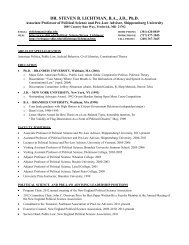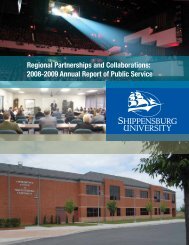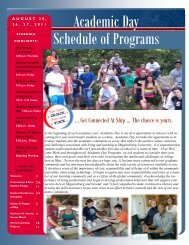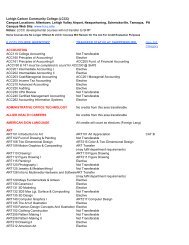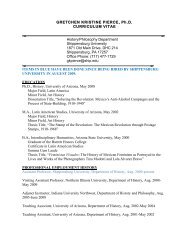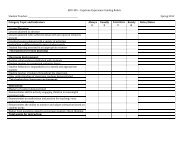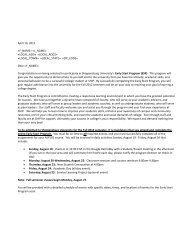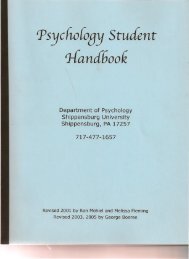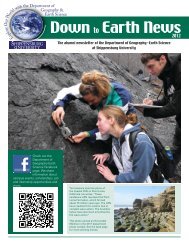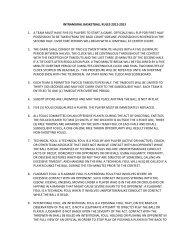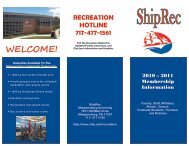Complete Issue - Shippensburg University
Complete Issue - Shippensburg University
Complete Issue - Shippensburg University
- No tags were found...
Create successful ePaper yourself
Turn your PDF publications into a flip-book with our unique Google optimized e-Paper software.
42 PROTEUS: A Journal of IdeasThe decision in Judge Wood’s court in Twin Fallswas never seriously in question. The tribe had filedinstream flow claims totaling the entire flow of theSnake River at Lewiston, its furthest downstreamlocation in Idaho. Finding in favor of the tribe wouldhave dried up irrigated agriculture in southern Idaho,by far the largest economic sector of the entire state.No state judge would issue such a ruling and JudgeWood proved no exception. The appeals of the SRBAcourt’s ruling were where the Tribe and the salmon’srights would be fought for and possibly won—probablynot at the Idaho Supreme Court where the same forcespresent in the District Court were at play—but at thenext stop in federal court. It was at this point, withappeals pending, that settlement negotiations becamethe focal point for deciding the tribe’s and the salmon’srights to water.It took another five years to bring the negotiationsto fruition, but in the end the salmon that managedto get past the eight mainstem dams were guaranteedenough water to survive within their current rangedownstream of southern Idaho’s irrigation and powerdams. At a minimum, the state agreed the Snake Riverflows established by the Swan Falls Agreement wouldbe provided for downstream instream flow. The statealso agreed to provide up to 427,000 acre feet in flowaugmentation for salmon from water stored behindsouthern Idaho dams. The tribe is to receive $95.8million and up to 11,000 acres of land to supportfishery and wildlife habitat acquisition, restoration,and protection. Among other provisions, the tribe is toassume sole management of the federal fish hatchery atKooskia and joint management of the Ahsahka federalfish hatchery just below Dworshak Dam. It will alsoreceive support for other tribal hatchery programs.The settlement is not without its detractors withinthe tribe. There are tribal members who wanted thetribe to pursue its case to its full extent within the courtsystem or, alternatively, argued that the settlementcompensation agreed to was inadequate. Whetherthe $95.8 million compensation was adequate washighlighted on April 7, 2008, when four downstreamColumbia River tribes and the federal governmentsigned an agreement giving those tribes just underone billion dollars for salmon restoration. In returnfor ten times the money given in compensation tothe Nez Perce for settling actual treaty rights, all thedownstream tribes need to do for their money is remainsilent for ten years whenever talk of breaching fourlower Snake River dams to restore salmon runs surfaces.The Nez Perce Tribe, while party to the negotiations onthe status of the lower Snake River dams, refused theproposed terms and did not sign the final agreement. 39With the finalization of the settlement of the NezPerce tribe’s instream flow claims, the last major hurdleto resolution of the 1984 Swan Falls Agreement—thesettlement of the dispute between Idaho PowerCompany and southern Idaho upstream irrigators thatgave birth to the Snake River Basin Adjudication—waspassed. The originally stipulated water conflicts of theMagic Valley irrigators and Idaho Power had beensettled.Six hundred and thirty river miles downstream anda world away, the Nez Perce people and the salmoncontinue their physical and spiritual partnership,dependent more than ever on each other for survival.The settlement assures there is enough water in therivers for the salmon to find the way to their natalstreams, and enough resources for the tribe to restoreand protect the river and stream habitat to supportspawning conditions. But the salmon must stillsomehow survive their passage through and aroundthe lower Snake and Columbia rivers’ eight fish-killingmainstem dams and reservoirs and the Nez Percepeople must still survive challenges to their culture,traditions, and sovereignty.The winter snows are melting once again, fillingrivers, and carrying young salmon downstream to thesea. When they return to Idaho as adults a few yearsfrom now, the Nez Perce will be there as they have beensince time immemorial to bless them and to receivethe salmon’s offering of themselves for the good of thepeople, the Nimi’puu. The cycle continues.The research described in this paper has been funded inpart by the United States Environmental Protection Agency(EPA) under the Greater Research Opportunities (GRO)Graduate Program. EPA has not officially endorsed thispublication and the views expressed herein may not reflectthe views of the EPA.ENDNOTES1. In re SRBA Case No. 38576, Consolidated Subcase 03-10022(Idaho Dist. Ct. Nov. 10, 1999).2. Ibid., 46.3. Ibid., 47.4. National Park Service, “Nez Perce National Historical Park,”http://www.nps.gov/nepe/ (accessed March 23, 2008).5. Alvin M. Josephy Jr., Nez Perce Country (Lincoln: <strong>University</strong> ofNebraska Press, 2007), 8.6. Steve Steubner, “No more ignoring the obvious: Idaho sucksitself dry” in Water in the West: A High Country News Reader, ed.Char Miller, Corvallis: Oregon State <strong>University</strong> Press, 2000.7. Save Our Wild Salmon, “Interactive Map,” http://www.wildsalmon.org/library/map2.cfm (accessed March 18, 2008).8. Columbia River Inter-Tribal Fish Commission, “Why SalmonAre Important,” http://www.critfc.org/sots/salmon_import.html(accessed March 18, 2008).9. Volcano World, “The Snake River Plain and the YellowstoneHot Spot,” http://volcano.und.edu/vwdocs/volc_images/north_america/yellowstone.html (accessed on March 19, 2008).10. Idaho State Historical Society, “The Oregon Trail in Idaho,”Reference Series #50.11. Twin Falls Canal Company, “Milner Dam,” http://www.tfcanal.com/milner.htm (accessed on March 18, 2008).12. Josephy, 71.



